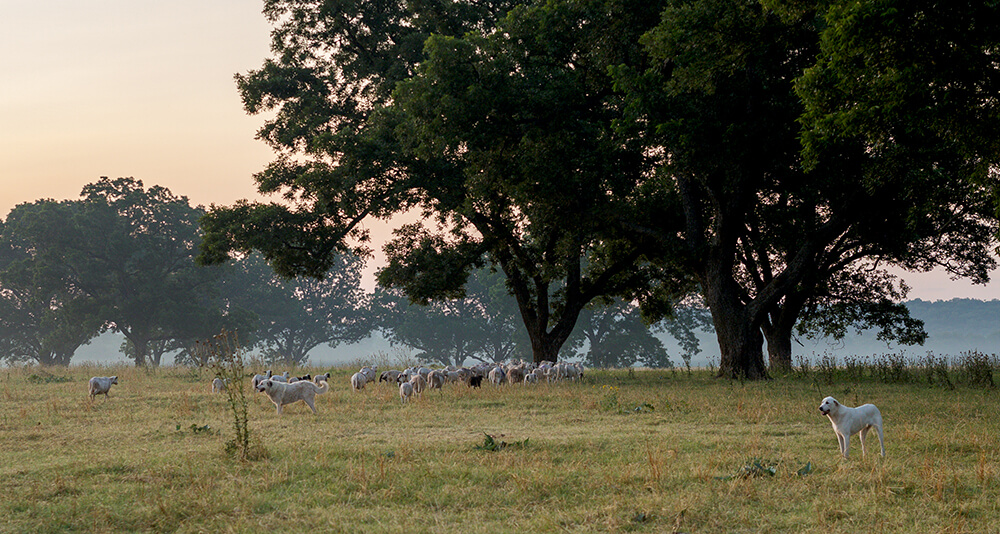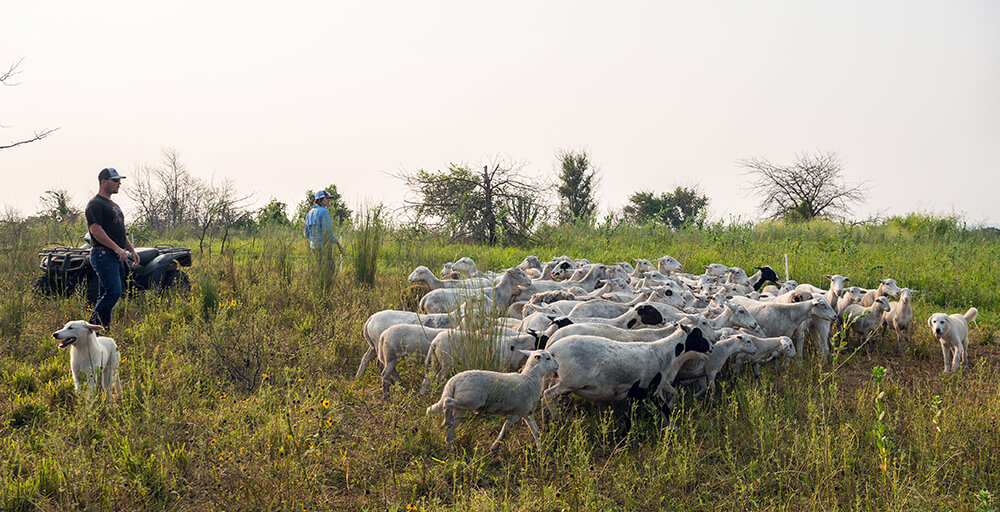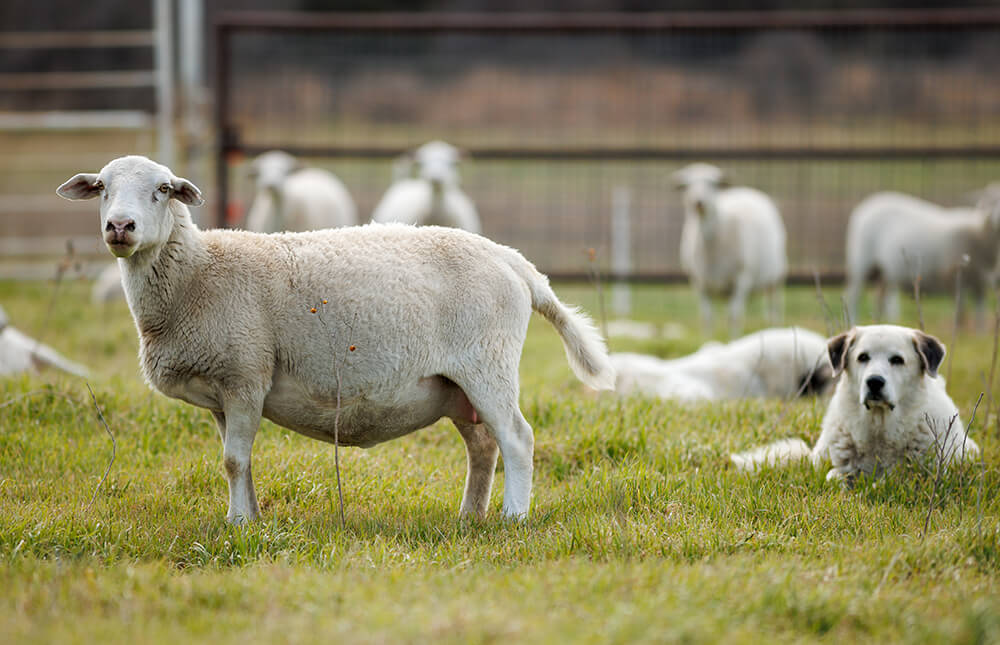Livestock guardian dogs play a valuable role in protecting small ruminants while they graze. Here are selection and training tips from a specialist in helping ranchers choose and train a successful guardian.
Livestock guardian dogs are the ultimate predator protection for a ranch’s small ruminants. Yet raising an effective guardian requires some know-how. Bill Costanzo, a livestock guardian dogs research specialist at Texas A&M AgriLife Center – San Angelo, studies what makes a guardian dog successful in its ranching role.
Costanzo has learned many ways to set up a pup for success, but in most cases, the essential basics are starting with good genetics, a sound training and socialization program, and some patience.

START WITH GOOD GENES
“The most important thing is to buy from reputable breeders with a working line of dogs who have livestock,” Costanzo says. “See the parents of that litter of puppies working.”
Often when ranchers call with problem puppies — especially those who are biting or chasing the livestock — Costanzo finds those dogs are not from purebred livestock guardian-dog stock. The presence of any show-dog lines or outside genetics, such as herding-dog genes, results in pups lacking the natural guardian instinct needed to be successful. In the worst cases, it produces dogs which have instincts and behaviors naturally antagonistic to their guardian roles, such as herding, chasing and biting.
While there are more differences between individual dogs than among the breeds, Costanzo notes there are still breed tendencies. Maremmano Sheepdogs tend to stay close and tight to the herd, while Anatolian Shepherd Dogs are known to work the perimeter and thrive in large territories. Akbash guardian dogs often show little tolerance for other dogs, while the Great Pyrenees are gentle giants more accepting of non-working dogs on the ranch. Kangal Shepherd Dogs and Komondors (Hungarian sheepdogs) have the tenacity to protect the flock against larger predators, but they may also be more aggressive to strangers.
Breed tendencies aside, much of an individual’s success comes from temperament and training. This is why picking the perfect puppy is of the utmost importance.
PICK YOUR PUPPY WELL
Once they have identified a litter of pure lines out of working parents, ranchers should visit the pups if possible. During that visit, note their parents, ensure that the puppies are being exposed to the same species of livestock you want them to protect, and interact with the litter to pick the pup with the best livestock guardian dog temperament.
Costanzo picks from the litter by looking for a curious puppy that still takes its job seriously.
“I am looking for the puppy that comes up to you, investigates you, gets a couple of pets, walks off and lays down,” he says. “I don’t want the pup that stays in front of me all the time — those dogs will crave human contact. I also don’t want the pup that doesn’t come up to me at all. That pup will be hard to catch in the field. It will be shy all the time and stay away from you.”

While many anecdotes tout the difference between male and female livestock guardian dogs, Costanzo has seen little difference between the genders. With intact males, their added roaming and aggression often cancel out any increased guarding ability. So, gender is less important to Costanzo when picking a pup than are the individual’s disposition, health and adaptability for their environment, such as choosing a shorter-haired breed for a sweltering climate.
Once the pup is selected, make arrangements with the breeders to pick up the puppy at 8 weeks old. Puppies weaned too early miss out on valuable lessons for how to act around other dogs, but waiting until the puppy is much older than that can hinder the bonding process. Costanzo’s research suggests the window in which pups best bond with the rancher’s chosen livestock starts at 5 weeks of age and closes a little before 14 weeks. In Costanzo’s experience, pups already bonded with the seller’s herd, or long-yearling livestock guardian dogs who join a new ranch well into the training process, are less likely to stay with their new herd, so he always suggests starting your own dog.
USE THESE STARTING STEPS
To train your 8-week-old puppy, Costanzo suggests starting with a bonding pen. In his experience, a 60-by-60-foot bonding pen with some sort of electrical fencing around the perimeter to help keep the puppies in works best. Costanzo puts four to six head of stock in the bonding pen along with the young pup, and he rotates the livestock regularly so that the puppy won’t get too attached to any specific animal. Dogs attached to a particular animal or animals may roam if that animal is later sold or culled.
Costanzo suggests ranchers who plan to use the dog to protect multiple species of livestock fill the bonding pen with examples of each species. At Texas A&M AgriLife Center – San Angelo, he places a hair sheep, wool sheep, meat goat and angora goat with each new pup.
This ensures the growing livestock guardian dog doesn’t get used to any specific species more than others. To do so can pose a problem for ranchers who plan to graze multiple species. If their dogs aren’t used to a certain species, such as cattle, they may be flighty or attempt to chase them to protect their herd, so be sure to match bonding species with your operation.
Once the pup has spent a month in the bonding pen with a small, diverse herd, you can move him or her into a 1-acre pen — with solid fencing reinforced with an electrical fencing system — until they are 6 months old. At 6 months of age, livestock guardian dogs are ready to protect their first pasture smaller than 30 acres. By the time they are 10 months old, dogs can cover 50-100 acres and protect the herd from small predators — coyotes, bobcats and foxes, especially when raised in pairs or paired with older, more experienced dogs.

SOCIALIZE FOR SUCCESS AND SAFETY
While you may have heard it’s best not to touch or socialize a livestock guardian dog pup, Costanzo says human socialization is one of the most important parts of the training process. Not only should you be able to catch your dog to move it from pasture to pasture or administer any necessary veterinary care, but unsocialized livestock guardian dogs are a liability.
Unsocialized dogs may be impossible to catch and care for or, even worse, may be aggressive. This creates a risk for your ranch by owning dogs that may bite hikers, hunters, stockmen, new workers, et. al., or that could pose a health risk to stock if you’re not able to handle the dog for proper healthcare.
“I’m very pro-socialization. In my opinion, you should be able to go out in your pasture, and you should be able to catch and call your dog,” Costanzo says. “Just because you socialize that puppy, you know, three or four times a week, doesn’t mean they’re going to end up at your back porch or headquarters all the time. We studied the dogs that were more socialized versus less socialized. Those more socialized dogs have not ended up at ranch headquarters any more than the less socialized dogs.”
Costanzo says each livestock guardian dog should know its name and the commands “come,” “no” and “stay.” In addition to these basic commands, the dog should be able to walk on a leash and stand tethered. This allows you to not only easily lead your dog but also keep it out of the way while working stock.

PATIENCE AND PRACTICE PAY OFF
All good things take time, and training a good livestock guardian dog is no different. Costanzo says it takes about two years to tell if your dog will make the cut. Along the way, each will likely go through puppy phases and challenges, which should be met with fair and stern discipline. For example, if a puppy shows up at ranch headquarters on its own, it should be promptly returned to its field.
Costanzo and his team use GPS trackers to help manage their many livestock guardian dogs spread out across several ranches, and they have successfully used electrical fencing as a training aid for dogs that like to roam.
But, even with a good guardian pedigree and a solid upbringing, not every dog is meant for the job. In Costanzo’s work, about 25% of the dogs that start training essentially flunk out of the program and are better suited as pets or outside ranch dogs with fewer responsibilities.
Like most things ranching-related, creating good guardian dogs takes good genetics, the right know-how, quite a bit of trial and error, and some luck. Yet, the resulting livestock guardian is a worthy investment that can protect your small ruminant investment for many years.
GUARDING NOBLE’S SMALL RUMINANTS
With Noble Ranches exploring new ways to manage ranchlands by grazing multiple species, ranch managers had to find a way to protect their small ruminants from predators. Kevin Pierce, ranch manager, has had great luck with livestock guardian dogs. To date, there have been no cases of predation in the flock of sheep Pierce manages with the dogs.
“We’ve had the sheep since last summer, close to the bank of the Red River. There are many predators down there, and we have had no trouble with them,” Pierce says.
Initially, the flock was looked after by two older dogs that were bonded to and accompanied the flock to Noble after its purchase. But, as these dogs aged, the ranch managers were tasked with bonding new puppies. That pair of pups are now well started and have been successfully protecting the flock of sheep, according to Pierce. But, as he says, using livestock guardian dogs requires a particular brand of stockmanship to care for and train them while learning their individual personalities.
“I think some people have the mindset that they can have these dogs, and they can just put a self-feeder out there,” Pierce says. “But I think you must treat your dog like any other animal and take care of it. They’re working for you, and they have an essential job to do.”
Want to learn how to build a movable feeding system helps keep your guardians’ nutrition close to their work as the herd is moved from one grazing paddock to another? Read In the Field: Movable Feeding Station for Guardian Dogs.














